Fermenting Beer with White Labs WLP095 Burlington Ale Yeast
Published: October 16, 2025 at 7:12:48 PM UTC
This article delves into the practical aspects of using White Labs WLP095 Burlington Ale Yeast for homebrewers and small breweries. It combines detailed specifications from White Labs with real-world comparisons and verified facts. This approach aims to provide comprehensive guidance on using WLP095 for fermentation.
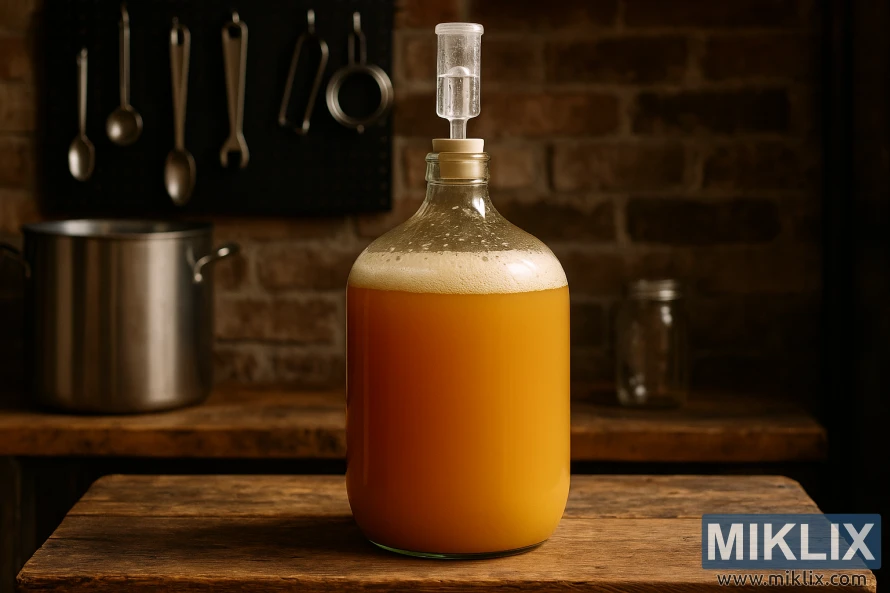
WLP095 is often associated with the Alchemist strain and the Northeast brewing style. It is available as a liquid culture and through White Labs’ Vault program, including an organic version. It exhibits medium flocculation, STA1 negative behavior, and can tolerate alcohol levels between 8–12% ABV.
In this review, you'll find technical details on the yeast's performance. Attenuation ranges from 73–80%, and the suggested fermentation temperature is 66–72°F. Many brewers, though, prefer temperatures between 67–70°F. The yeast's flavor profile includes esters, stonefruit, citrus, and tropical notes, enhancing the character of modern hazy IPAs and pale ales.
The article will also explore practical aspects such as pitching rates, temperature control, managing diacetyl risk, and dry-hop interactions. It aims to help you use White Labs WLP095 to enhance the body and hop character in your beers, focusing on juicy, haze-forward styles.
Key Takeaways
- White Labs WLP095 Burlington Ale Yeast is suited for New England–style IPAs and juicy pale ales.
- Expect attenuation near 73–80% and medium flocculation with 8–12% ABV tolerance.
- Recommended fermentation range is about 66–72°F, with 67–70°F often optimal.
- Flavor contribution includes esters and stonefruit/citrus notes that boost hop aroma.
- Manage diacetyl risk with proper warm conditioning and attentive temperature control.
Introduction to White Labs WLP095 Burlington Ale Yeast
WLP095 Burlington Ale Yeast is a liquid strain from White Labs, leading the haze craze in New England–style IPAs. This introduction highlights a Saccharomyces cerevisiae culture, available in White Labs Vault packaging. An organic variant is also offered for brewers seeking certified ingredients.
Brewers opt for this strain due to its Burlington Ale Yeast background. It originates from the Northeast U.S. brewing scene, mirroring Vermont-style strains popularized by The Alchemist. The yeast profile showcases an attenuation of 75–80%, medium flocculation, and alcohol tolerance up to 12%.
It's ideal for hazy, fruit-forward ales where a full body and soft mouthfeel are crucial. Fermentation occurs best at 66–72°F (19–22°C). The strain is STA1 negative, making it perfect for both homebrew and commercial batches. It ensures juicy hop expression without thinness.
The brewing community praises its ability to create estery, rounded fermentation while preserving hop aroma. This makes WLP095 a top choice for New England–style IPAs and other modern ale styles.
Key Brewing Characteristics of Burlington Ale Yeast
WLP095 brewing characteristics focus on efficient sugar conversion, ideal for hazy, hop-forward beers. Attenuation ranges from 73–80 percent, with White Labs specifying 75–80 percent. This range ensures final gravities are consistent for pale ales, IPAs, and stronger doubles.
The yeast's flocculation is medium, resulting in beers that retain some haze and body. This characteristic is crucial for New England–style IPAs, enhancing mouthfeel and hop suspension. It also prevents excessive clearing seen in high-flocculent strains.
WLP095 can handle alcohol levels up to 8–12 percent ABV, making it suitable for imperial styles. This tolerance allows brewers to create high-gravity beers without compromising yeast performance or fermentation quality.
Being STA1-negative, WLP095 lacks turbo-diastase activity, which is linked to dextrin fermentation. This absence contributes to a balanced malt body, complementing hop bitterness without thinning the beer's finish.
- Predictable attenuation supports consistent final gravities.
- Medium flocculation preserves haze and soft mouthfeel.
- Moderate-to-high alcohol tolerance suits higher-gravity recipes.
The yeast introduces ester-driven fruitiness, which complements citrus and tropical hops. This flavor profile, combined with steady attenuation, facilitates the creation of balanced, aromatic beers with a satisfying body.
Optimal Fermentation Temperature and Management
White Labs suggests a temperature range of 66–72°F (19–22°C) for WLP095 fermentation. Practical brewers often refine this to 67–70°F (19–21°C). This range balances ester production and attenuation when using Burlington Ale Yeast.
Pitching at a lower temperature is beneficial. Aim for 66–67°F (19°C) to ensure a gentle yeast settling. As fermentation becomes active, move into the mid-range. This allows esters to develop without overpowering the delicate hop character.
Higher temperatures can enhance ester formation but also increase diacetyl risk. Lower temperatures result in cleaner profiles and a more focused malt character. Choose your target flavor based on the temperature range you plan to use.
- Start: pitch at ~66–67°F (19°C).
- Active phase: allow 67–70°F (19–21°C) for desired ester balance.
- End: raise 2–4°F for 24–48 hours after apparent terminal gravity if diacetyl is present.
Managing the end-of-fermentation temperature can help reduce diacetyl. A 2–4°F increase for one to two days allows yeast to reabsorb off-flavors. Monitor gravity and aroma before and after this temperature adjustment.
Keep track of fermentation progress with gravity readings, airlock activity, and sensory checks. Ensure good sanitation during racking and transfers to prevent oxidation when fermenting Burlington Ale Yeast.
Consistent temperature control is key to achieving predictable results. Utilize a chamber, ferm-wrap, or heat belt to maintain a steady WLP095 fermentation temperature. This will help deliver the flavor profile you envisioned.
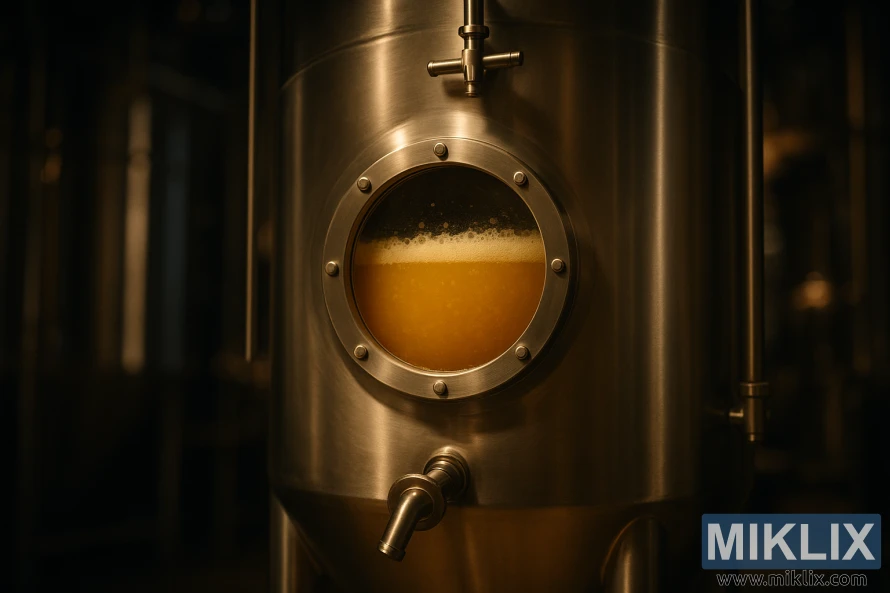
Flavor and Aroma Profile When Using WLP095
WLP095 offers a distinct flavor profile, rich in stonefruit and citrus notes. Tasting experiences often highlight peach, apricot, orange, pineapple, and tropical flavors. The aroma of Burlington Ale Yeast emerges early in fermentation and intensifies post-dry hopping.
This strain produces more esters than typical yeasts like WLP001. In bench trials, WLP095 showcased the most intense aroma, with warm orange and subtle malt notes before dry hopping. Post-dry hopping, the esters of peach and apricot became dominant, blending with hop oils.
The yeast contributes to a fuller body, ideal for juicy and hazy IPA styles. This fuller mouthfeel balances hop bitterness, allowing esters of peach, apricot, and citrus to complement hop-derived flavors.
Be cautious of diacetyl. Burlington Ale Yeast aroma may include diacetyl if fermentation cools too soon. Regular sensory checks and short warm rests can mitigate this risk, preserving the fruit-forward esters.
Hop synergy is a significant advantage. Esters of peach, apricot, and citrus enhance hop character rather than masking it. Late hopping and dry hopping are recommended to showcase both the Burlington Ale Yeast aroma and the WLP095 flavor profile.
Performance in New England–Style IPAs and Hazy Beers
WLP095 NEIPA performance is a topic of interest for brewers aiming for a soft, fruity taste. This strain has a heritage linked to a renowned Northeast brewery. It behaves like many Vermont-style strains, producing moderate esters that enhance stonefruit and tropical flavors.
Burlington Ale yeast is ideal for hazy IPAs where brewers seek pronounced yeast-driven fruitiness. It pairs well with hops like Citra and Motueka. The yeast's medium flocculation ensures some turbidity without extreme silkiness.
The Alchemist strain NEIPA is known for its clear hop character. Fruit-forward esters from the yeast complement juicy hop additions. This way, citrus and stonefruit tones remain noticeable even after vigorous dry hopping.
Expect variability based on the recipe and dry-hop method. WLP095 can produce clearer beers than strains like WLP008 or WLP066 after heavy dry hopping. Haze outcomes depend on adjuncts, proteins, and hop oils as much as yeast choice.
Brewers aiming for maximum haze might prefer WLP008 or WLP066. Adjusting adjuncts and hopping protocols can also help. For balanced fruit and clarity, Burlington Ale yeast for hazy IPA offers consistent mouthfeel and a supportive ester profile. This boosts perceived hop juiciness.
Suggested Beer Styles for WLP095 Burlington Ale Yeast
WLP095 excels in hazy and juicy hop-forward beers. It's a top choice for Hazy/Juicy IPA, enhancing tropical and stonefruit hop flavors with fruity esters. The yeast also contributes a soft mouthfeel, perfect for New England–style IPAs and maintaining haze.
Pale ale, single IPAs, and double IPAs are at the heart of the WLP095 style list. This yeast adds subtle fruit notes and a clean finish, boosting drinkability. It can handle higher gravities, ensuring balanced ester presence. This makes WLP095 ideal for full-flavored, aromatic hoppy beers.
Don't limit WLP095 to hop-forward beers; it also works well in malt-forward recipes. Brown ale, red ale, porter, and stout can all benefit from its use. The ester profile brings warm fruit hints that complement caramel, toffee, and chocolate malts. These additions enhance the darker malt flavors without overpowering them.
- Primary recommendations: Hazy/Juicy IPA, Pale Ale, IPA & Double IPA.
- Secondary matches: Brown Ale, Red Ale, Porter, Stout.
- ABV fit: Suitable for session to higher-gravity beers within an ~8–12% tolerance range.
When planning recipes, refer to a targeted WLP095 style list. This ensures yeast character aligns with hop and malt choices. Such alignment is why many brewers consider WLP095 among the best for Burlington Ale Yeast, leading to consistent, flavorful results.
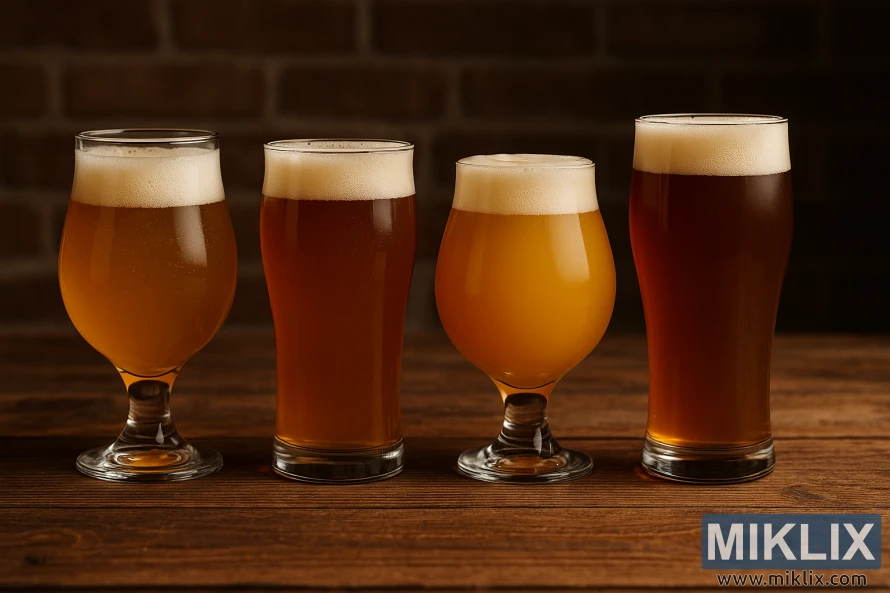
Pitching Rates and Yeast Handling Recommendations
When planning your WLP095 pitching rate, aim for target cell counts. For typical 5-gallon ales, follow White Labs' pitching recommendations. These are based on original gravity and batch size. For high-gravity worts, use a starter or extra vials to reach the suggested cell counts. This helps avoid stressed fermentation.
When handling Burlington yeast, be meticulous. Store Vault packs or liquid vials in the refrigerator until use. Always check the production dates. For small split batches, many brewers use half a pouch for a 1-gallon test. Yet, it's crucial to match White Labs' pitching recommendations for reliable attenuation and flavor.
The pitching temperature is critical. Add yeast near the low end of the recommended range, around 66–67°F (19°C). This favors controlled ester formation. Cooler initial pitching helps manage aromatic esters in hazy and hop-forward beers, while still ensuring a strong start.
Before pitching, prepare wort oxygenation and sanitation. Adequate oxygenation supports healthy yeast growth. Then, maintain strict sanitation during transfers to limit oxidation and contamination. Good oxygen and clean equipment enhance fermentation vigor and final hop clarity.
For storage and quality assurance, prefer STA1-negative Vault packaging or fresh White Labs liquid vials. Refrigerate as instructed by the manufacturer and avoid repeated warm cycles. Proper storage preserves viability and ensures lab-verified quality checks.
- Use a starter or extra pouches for high-gravity beers.
- Follow White Labs pitching recommendations for cell counts.
- Pitch at ~66–67°F (19°C) for controlled ester production.
- Oxygenate wort and practice rigorous sanitation.
- Store Vault and vials refrigerated and check dates.
Fermentation Timeline and Expected Gravity Changes
Active fermentation with White Labs WLP095 often begins within 12–48 hours after pitching. The WLP095 fermentation timeline shifts with pitch rate, wort oxygenation, and temperature control.
Primary activity usually slows by day 3 to day 5. Many ales fermented with this strain reach terminal activity between days 5 and 10 when held at recommended temperatures.
Expect gravity changes Burlington Ale yeast will produce a steady drop early, then a taper as dextrins remain in solution. For a 1.070 starting gravity split-batch NEIPA, WLP095 reached an expected FG WLP095 near 1.014, giving a medium body and about 7.3% ABV.
Attenuation for Burlington Ale yeast commonly falls in the 73–80% range. That range predicts final gravities that leave modest residual sweetness and improved mouthfeel for haze retention.
- Monitor gravity daily with a hydrometer or refractometer during active fermentation.
- Record gravity changes Burlington Ale yeast to spot stalled activity early.
- Perform a diacetyl check late in fermentation and consider a short diacetyl rest if needed.
If off-flavors appear, a controlled temperature rise near the end of primary can help yeast clean up compounds before conditioning. Tracking the WLP095 fermentation timeline and the expected FG WLP095 lets brewers make small corrections without upsetting beer balance.
Diacetyl Risk and How to Prevent It
WLP095 diacetyl can manifest as a buttery or toffee-like off-flavor when Burlington Ale yeast doesn't fully process it. White Labs cautions that this strain might produce more diacetyl than others. Brewers need to monitor the aroma near terminal gravity and after packaging to detect any early signs.
Prevention begins with proper pitching rates and oxygenation. A healthy, well-aerated wort aids yeast in completing their metabolic cycles, thus reducing diacetyl production.
Temperature management during fermentation is crucial. Keep the fermentation within the recommended range for WLP095. Plan a diacetyl rest by raising the temperature 2–4°F (1–2°C) for 24–48 hours once primary activity slows or gravity approaches final.
After the rest, allow time for yeast to reabsorb diacetyl before cold conditioning or packaging. Rushing to cold crash can trap diacetyl in the beer.
- Ensure adequate yeast cell count and oxygen at pitch.
- Maintain steady fermentation temperatures to limit early diacetyl formation.
- Perform the diacetyl rest WLP095 for 24–48 hours near the end of fermentation.
- Hold beer warm long enough post-rest so yeast can reduce diacetyl levels.
If diacetyl appears after packaging, remediation varies by scale. Commercial brewers can condition at warmer temperatures or repitch active yeast to reabsorb diacetyl. Homebrewers should focus on preventing the issue through proper pitching, oxygenation, and the diacetyl rest.
Preventing diacetyl in Burlington Ale requires predictable fermentation control and timely sensory checks. Regular tasting around terminal gravity allows for correction before packaging.
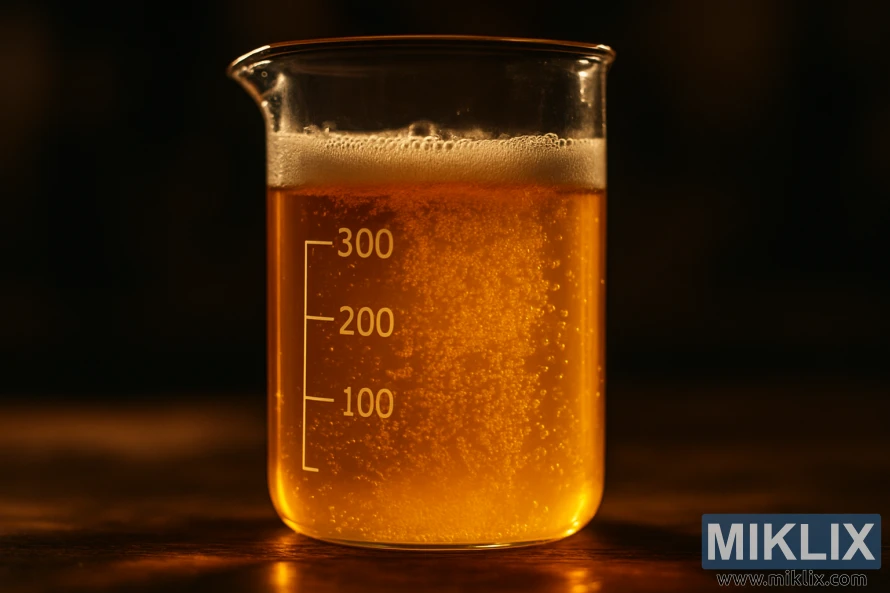
Dry Hopping Interactions and Hop Character Amplification
WLP095 dry hopping often brings out stonefruit esters from the yeast while keeping hop aroma clear and focused. Brewers report a Burlington Ale yeast hop interaction that blends yeast-derived peach and apricot notes with citrus-forward hops.
Choose hops that complement the yeast esters. Citra, Motueka, and similar citrus/tropical varieties pair well with the natural fruitiness of WLP095 dry hopping. These combinations tend to emphasize hop character WLP095 without masking yeast-derived complexity.
Follow conservative dosing when using Cryo products. High Cryo charges can push herbal or peppery traits that conflict with the Burlington Ale yeast hop interaction. Start lower, then adjust in future batches based on taste.
Timing matters. Add dry hops later in active fermentation, commonly between day 5 and day 8, to capture volatile aromatics and reduce grassy or vegetative bitterness. Sampling pre- and post-dry hop helps isolate changes driven by the yeast versus the hops.
Expect changes in haze and mouthfeel. WLP095 may produce less haze than strains like WLP008 or WLP066 under the same conditions. Dry hop additions can increase turbidity and alter perceived ester intensity, so plan for extra conditioning if clarity is a priority.
- Experiment with split-batch trials to compare hop blends and charges.
- Use smaller Cryo charges, then scale up if the hop character WLP095 remains balanced.
- Match hop choices to the yeast’s fruit-forward profile for the strongest synergy.
Comparisons and Substitutes for Burlington Ale Yeast
Brewers often seek alternatives when WLP095 is out of stock. Common substitutes include OYL-052, GY054, WLP4000, and A04. These strains, from the Vermont/Conan family, offer similar ester-driven fruitiness and haze potential.
When comparing Burlington Ale yeast, note the differences in mouthfeel and ester balance. WLP095 leaves more body and fruity esters than a neutral California strain. WLP001 (California Ale/Chico) will be cleaner, allowing hop character to dominate.
Some brewers prefer WLP008 or WLP066 for extreme haze and bright citrus notes. In head-to-head trials, WLP095 produced notable fruitiness but sometimes a clearer finish than those strains. Choose WLP008 or WLP066 for pronounced haze and citrus lift.
GY054 and OYL-052 are often cited as near equivalents. Use GY054 vs WLP095 when you want nearly identical fermentation behavior in NEIPAs. Both drive soft esters and work well with heavy late hopping and dry hopping schedules.
- For similar haze and ester profile: choose GY054 or OYL-052.
- For a cleaner, more neutral canvas: choose WLP001.
- For brighter citrus and heavier haze: choose WLP008 or WLP066.
Substitute selection should match your target final gravity and desired ester level. If a recipe calls for WLP095 and you want the same fruit-forward profile, GY054 vs WLP095 is a reliable swap. Adjust pitch rate and temperature to preserve intended character when changing strains.
Packaging, Conditioning, and Carbonation Considerations
When planning WLP095 packaging, consider the yeast's medium flocculation. Some yeast remains suspended after fermentation. This residual yeast aids in natural conditioning in bottles or kegs, enhancing mouthfeel.
Before packaging, conduct a diacetyl rest and allow the culture to eliminate off-flavors. Cold crash only after yeast cleanup is complete. This approach minimizes diacetyl trapping during cold conditioning of Burlington Ale yeast beers.
Carbonation options for WLP095 include kegging and bottling. For kegging, force carbonate after sufficient conditioning. Cold-conditioning in the keg can enhance body while preserving haze.
For bottling, ensure enough viable yeast for bottle-conditioning. High-gravity beers might require a fresh, low-attenuating priming strain for consistent carbonation and to avoid under-carbonated bottles.
Avoid oxygen pickup during transfers and packaging. NEIPAs and hop-forward ales are highly susceptible to oxidation. Even small amounts of oxygen can degrade hop aroma and diminish the ester-hop synergy that defines Burlington Ale yeast beers.
- Check terminal gravity before packaging to confirm attenuation and yeast viability.
- Perform diacetyl rest at 68–72°F for 24–48 hours, then cold condition if haze retention is not a priority.
- When bottle-conditioning, calculate priming sugar and consider adding a sachet of dry ale yeast for higher OG beers.
Aging and shelf life are crucial for maintaining freshness. Beers fermented with WLP095 are best enjoyed within weeks to capture peak ester-hop synergy. Extended storage can mute hop character and reduce yeast-driven fruitiness.
Monitor CO2 levels and taste during conditioning to achieve your target carbonation. Proper handling during packaging ensures stable carbonation WLP095, preserving the beer's intended aroma and mouthfeel.
Troubleshooting Common Fermentation Issues with WLP095
Slow or stuck fermentation often stems from low pitch rates, poor oxygenation, or fermentation temperatures below the White Labs recommended range. For WLP095 troubleshooting, warm the fermenter into the proper window and check gravity readings. If the beer shows little activity early, oxygenate and consider adding a healthy starter or a fresh slurry to restore yeast count.
High-gravity worts need more cells and nutrient support. Underpitching a big IPA will stall fermentation. Address Burlington Ale yeast problems by stepping up cell numbers before pitch or by adding a robust ale strain to finish the ferment safely.
Excessive diacetyl can appear when fermentation slows near the end or when temperatures drop abruptly. For fermentation issues WLP095 with buttery notes, perform a diacetyl rest by raising temperature 2–4°F (1–2°C) for 24–48 hours. Confirm final gravity and give the yeast time to reabsorb diacetyl before cold conditioning.
Off aromas after dry hopping may come from aggressive hop choices or overuse of concentrated products like Cryo hops. If Burlington Ale yeast problems show as herbal or peppery phenolics, cut dry hop rates and select hops that match the malt and yeast profile. Extended conditioning often helps mellow harsh hop character.
When haze is weaker than expected, remember WLP095 has moderate flocculation. For haze-seeking beers, add oats or wheat, tweak your mash to preserve protein, or pick a more haze-prone strain such as WLP008 or WLP066. These steps solve common WLP095 troubleshooting cases around appearance.
Oxidation and fast flavor degradation ruin hop-forward beers. Prevent fermentation issues WLP095 by minimizing oxygen exposure during racking and packaging. Use closed transfers, purge packages with CO2, and package promptly to lock in bright hop aromas.
- Slow/stuck: warm fermenter, oxygenate early, add starter or fresh yeast.
- Diacetyl: raise temp for a 24–48 hour rest, verify FG, allow reabsorption.
- Phenolic/off dry-hop notes: cut dry-hop rates, choose complementary varieties, condition longer.
- Lack of haze: add oats/wheat, adjust mash, consider alternate strains.
- Oxidation: closed transfers, CO2 purging, quick packaging.
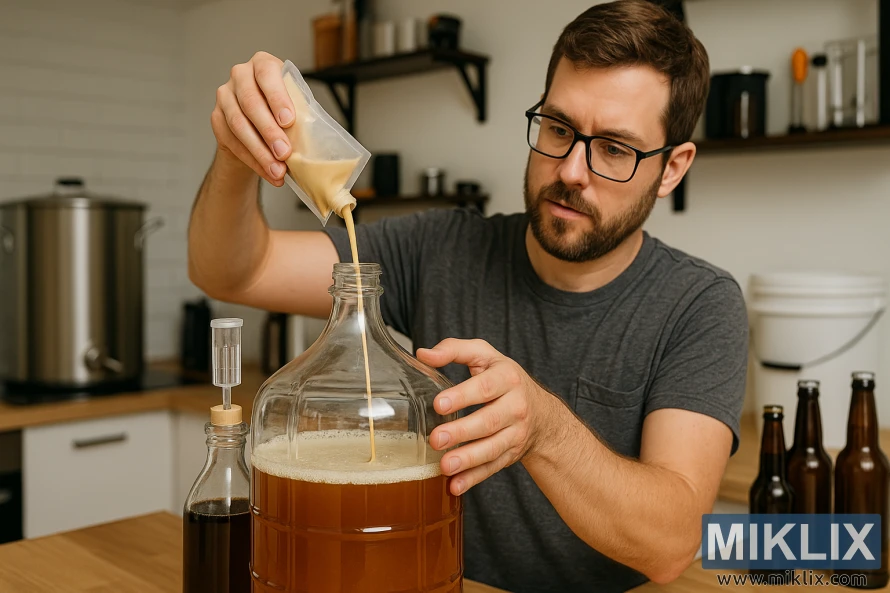
Practical Recipe Ideas and Example Ferment Schedules
Begin with a New England IPA as your foundation. Use pale malt, wheat, and flaked oats to enhance body and haze. A typical mix is 80% pale malt, 10% wheat malt, and 10% flaked oats. Aim for an Original Gravity (OG) between 1.060 and 1.075 for most WLP095 recipes.
IBUs should be moderate. This approach emphasizes the juicy hop flavors. Reserve most hop additions for late boil, whirlpool, and dry hop stages. Opt for hops like Citra, Mosaic, Motueka, or El Dorado for a balanced flavor in your Burlington Ale NEIPA recipe.
- OG target: 1.060–1.075
- Expected FG with WLP095: mid-to-high 1.010–1.015
- Grain ratio: 80% pale malt / 10% wheat / 10% flaked oats
- Hop focus: late additions + layered dry hop
Here's an example ferment schedule WLP095 brewers follow:
- Pitch at 66–67°F (19°C).
- Active fermentation day 1–3; allow rise to 67–70°F (19–21°C) by day 3–5.
- Dry hop between day 5–7, timing based on activity and krausen.
- When gravity nears terminal (often day 5–8), raise temperature 2–4°F (1–2°C) for 24–48 hours for a diacetyl rest.
- Cold crash and condition after yeast cleanup, then package.
In split-batch experiments, a 1.070 OG pitched conservatively reached about 1.014 FG and yielded roughly 7.3% ABV. This trial demonstrates how pitching rate impacts attenuation and ester expression. For consistent results, adhere to a consistent ferment schedule WLP095 and monitor gravity daily during peak activity.
Practical tips for WLP095 recipes include making a healthy starter or using appropriate cell counts. Avoid overusing Cryo hops, as they can mask yeast character. Also, protect packaged beer from oxygen to preserve hop and yeast aromas. Sampling during fermentation reveals transient yeast notes that fade with conditioning.
Conclusion
WLP095 conclusion: Burlington Ale Yeast is a versatile, ester-forward liquid strain. It excels in New England–style IPAs, pale ales, and malt-forward beers. It offers pronounced stonefruit and citrus esters, medium flocculation, and moderate-to-high attenuation in the 73–80% range. Its body-enhancing character ensures hop flavors sit smoothly in the beer, enhancing the yeast-driven fruitiness.
Burlington Ale Yeast summary includes key strengths and cautions for brewers. Its strengths are evident: lively esters, alcohol tolerance around 8–12%, and the availability of White Labs Vault or organic options. Yet, it has a higher diacetyl tendency, requiring a deliberate diacetyl rest and careful fermentation control. WLP095 can produce variable haze; strains like WLP008 or WLP066 may produce more persistent turbidity when haze is the primary goal.
For the best uses WLP095, plan your pitch rate, temperature schedule, and dry-hop timing. This allows the yeast’s fruit esters to support juicy hop bills without diacetyl or off-flavors dominating. In short, WLP095 is a strong choice for yeast-driven fruit character that complements modern hop profiles while offering reliable performance for a range of ale styles.
Further Reading
If you enjoyed this post, you may also like these suggestions:
- Fermenting Beer with Bulldog B49 Bavarian Wheat Yeast
- Fermenting Beer with Lallemand LalBrew BRY-97 Yeast
- Fermenting Beer with Fermentis SafAle K-97 Yeast
